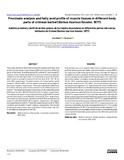Proximate analysis and fatty acid profile of muscle tissues in different body parts of crimean barbel (Barbus tauricus Kessler, 1877)

Voir/
Date
2023Palabras Clave
Barbus tauricus, Ácidos grasos, Composición nutricional, EPA, DHABarbus tauricus, Fatty acids, Nutritional composition, EPA, DHA
Metadatos
Afficher la notice complèteRésumé
This study aimed to determine proximate analysis and fatty acid
profile of whole body muscle tissue (WM) and muscles in different
parts of the body, including dorsal (D), ventral (V), and caudal (C)
regions, of the crimean barbel (Barbus tauricus), which is an species
caught from the Gelingüllü Dam. In whole body muscle the protein,
lipid, moisture, and ash contents of the fish were 18.61, 1.54, 78.49,
and 1.09% respectively. The lipid contents of crimean barbel varied
between 1.78 and 2.68%, with the highest and lowest percentages in
the C and V regions, respectively. There was a significant difference
(P<0.05) in the fatty acid content present in the different parts of
the fish. The highest and lowest proportions of saturated fatty acids
(SFA) were found in WM (23.03) and D (21.94%) region, respectively.
The highest and lowest monounsaturated fatty acid (MUFA) contents
were found in the D muscle (36) and V muscles (33.73%), respectively.
The proportion of polyunsaturated fatty acids (PUFA) was highest and
lowest in C (25.63) and D (22.62%) regions, respectively. The highest
eicosapentaenoic acid (4.11) and docosahexaenoic acid (12.98%)
contents were found in V and C regions, respectively. The results
showed that lipid content and composition of fatty acids may vary
in the different body parts of the fish.
Colecciones
Información Adicional
| Otros Títulos | Análisis proximal y perfil de ácidos grasos de los tejidos musculares en diferentes partes del cuerpo del barbo de Crimea (Barbus tauricus Kessler, 1877) |
| Correo Electrónico | esra.balikci@bozok.edu.tr |
| Editor | SaberULA |
| ISSN | 0798-2259 |
| ISSN Electrónico | 2477-944X |
| Resumen en otro Idioma | Este estudio tuvo como objetivo determinar el análisis proximal y el perfil de ácidos grasos del tejido muscular de todo el cuerpo (WM) y los músculos en diferentes partes del cuerpo, incluidas las regiones dorsal (D), ventral (V) y caudal (C), del barbo de Crimea. (Barbus tauricus), que es una especie capturada en la Presa Gelingüllü. Los contenidos de proteína, lípidos, humedad y cenizas del pescado fueron 18,61; 1,54; 78,49 y 1,09 %, respectivamente. Los contenidos de lípidos de del barbo de Crimea. variaron entre 1,78 y 2,68 %, con los porcentajes más altos y más bajos en las regiones C y V, respectivamente. Hubo una diferencia significativa (P<0,05) en el contenido de ácidos grasos presentes en las diferentes partes del pez. Las proporciones más altas y más bajas de ácidos grasos saturados (AGS) se encontraron en la región WM (23.03) y D (21.94 %), respectivamente. Los contenidos más altos y más bajos de ácidos grasos monoinsaturados (MUFA) se encontraron en las regiones del músculo D (36 %) y los músculos V (33.73 %), respectivamente. La proporción de ácidos grasos poliinsaturados (PUFA) fue mayor y menor en las regiones C (25.63) y D (22.62 %), respectivamente. Los mayores contenidos de ácido eicosapentaenoico (4.11 %) y ácido docosahexaenoico (12.98 %) se encontraron en las regiones V y C, respectivamente. Los resultados mostraron que el contenido de grasa y la composición de ácidos grasos varian en las diferentes partes del cuerpo del pez. |
| Colación | 1-5 |
| País | Venezuela |
| Institución | Universidad del Zulia (LUZ) Universidad de Los Andes (ULA) |
| Publicación Electrónica | Revista Científica |
| Sección | Revista Científica: Artículos |





